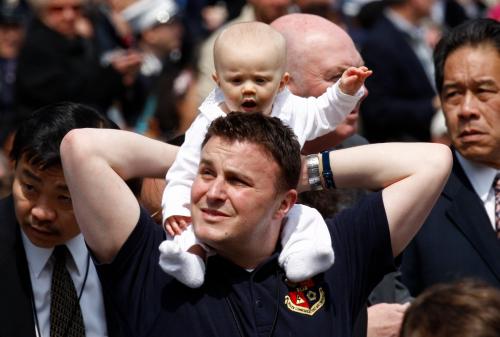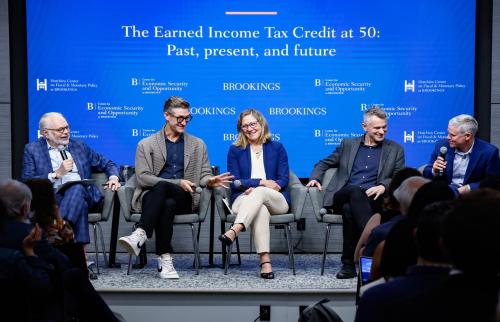This report was produced by the AEI-Brookings Working Group on Paid Family Leave, a joint AEI-Brookings initiative co-directed by AEI’s Aparna Mathur and Brookings’ Isabel Sawhill.
The U.S. is the only developed nation without a national paid family leave policy. Though a handful of states have created their own policies—including California, New Jersey, Rhode Island, New York, and the District of Columbia—the plans have a lack of public awareness and low take-up rates. And while some private employers offer paid family leave policies, employer-provided paid leave is concentrated among high-income workers; a majority of those below media income received no pay while on leave. In “Paid family and medical leave: An issue whose time has come” (PDF), the joint AEI-Brookings Working Group on Paid Family Leave—a group comprised of experts with experience in both Democratic and Republican administrations—takes a closer look at the need for federal paid family leave, highlighting the benefits and costs of providing paid leave from the perspective of workers, businesses, and society.
Polls show overwhelming public support for paid family and medical leave. Support for the concept is bipartisan, with almost 71 percent of Republicans and 83 percent of Democrats in favor a paid leave policy. Though the federal Family and Medical Leave Act, passed in 1993, offers 12 weeks of job-protected, unpaid leave, only about 60 percent of the workforce is eligible for its protections. The working group focused on the particular need for federal paid parental leave, pointing to three primary reasons the U.S. needs a federal policy:
- The composition of the workforce and the demands on working families have changed dramatically over recent decades, meaning far more parents are struggling to balance the competing demands of work and family.
- A growing body of evidence shows children fare better when their parents have access to leave, and individuals are more likely to take leave when it is paid.
- National economic growth depends on strong labor force participation by both men and women. Paid parental leave enables parents to remain in the labor force while caring for their new children.
 Public support in creating such a policy has grown in the past few years, with 82 percent supporting paid maternity leave and 69 percent supporting a paid paternity leave policy. While many policy proposals exist, including the FAMILY Act sponsored by Rep. Rosa DeLauro (D-CT) and Sen. Kirsten Gillibrand (D-NY), President Trump’s campaign proposal, and the Strong Families Act introduced by Sen. Deb Fischer (R-NE) and cosponsored by Senators Angus King (I-ME) and Marco Rubio (R-FL), the working group seeks to bridge the partisan divide over the issue with their own compromise policy. The authors’ suggest a compromise plan should contain five elements:
Public support in creating such a policy has grown in the past few years, with 82 percent supporting paid maternity leave and 69 percent supporting a paid paternity leave policy. While many policy proposals exist, including the FAMILY Act sponsored by Rep. Rosa DeLauro (D-CT) and Sen. Kirsten Gillibrand (D-NY), President Trump’s campaign proposal, and the Strong Families Act introduced by Sen. Deb Fischer (R-NE) and cosponsored by Senators Angus King (I-ME) and Marco Rubio (R-FL), the working group seeks to bridge the partisan divide over the issue with their own compromise policy. The authors’ suggest a compromise plan should contain five elements:
- Public paid parental leave would be available to both employed mothers and fathers (with strict eligibility requirements), so that working parents do not need to return to work within days of a child’s birth or adoption.
- Any plan would be budget neutral, splitting costs of financing between a payroll tax and cutting government spending or tax expenditures elsewhere in a way that does not adversely affect low-income families.
- The proposal would keep the benefits relatively targeted and inexpensive by offering a 70 percent replacement rate up to a cap of $600 per week for a limited number of weeks (e.g., eight weeks).
- The proposal would include job protection.
- It would require an independent study of the effects of paid family leave to ensure that such a policy is not having significant unintended consequences, such as crowding out existing plans or leading to discrimination.
Although there was disagreement in the group about the specific design of a paid leave policy, the group unanimously agreed that some form of paid parental leave should be offered to help workers at the time of birth, adoption, or fostering of a child:
“Our working group met numerous times and engaged in a spirited and constructive discussion of these issues. We did not agree on every issue but we all agreed it is time to provide some paid time off for new parents, especially the least advantaged. We hope our efforts will help educate others on the best way to move forward in expanding American workers’ access to paid leave when they need it most.”
Download the full report here (PDF).
The joint AEI-Brookings Working Group on Paid Family Leave includes Aparna Mathur (codirector), Isabel Sawhill (codirector), Heather Boushey, Ben Gitis, Ron Haskins, Doug Holtz-Eakin, Harry J. Holzer, Elisabeth Jacobs, Abby M. McCloskey, Angela Rachidi, Richard V. Reeves, Christopher J. Ruhm, Betsey Stevenson, and Jane Waldfogel.
The Brookings Institution is committed to quality, independence, and impact.
We are supported by a diverse array of funders. In line with our values and policies, each Brookings publication represents the sole views of its author(s).





